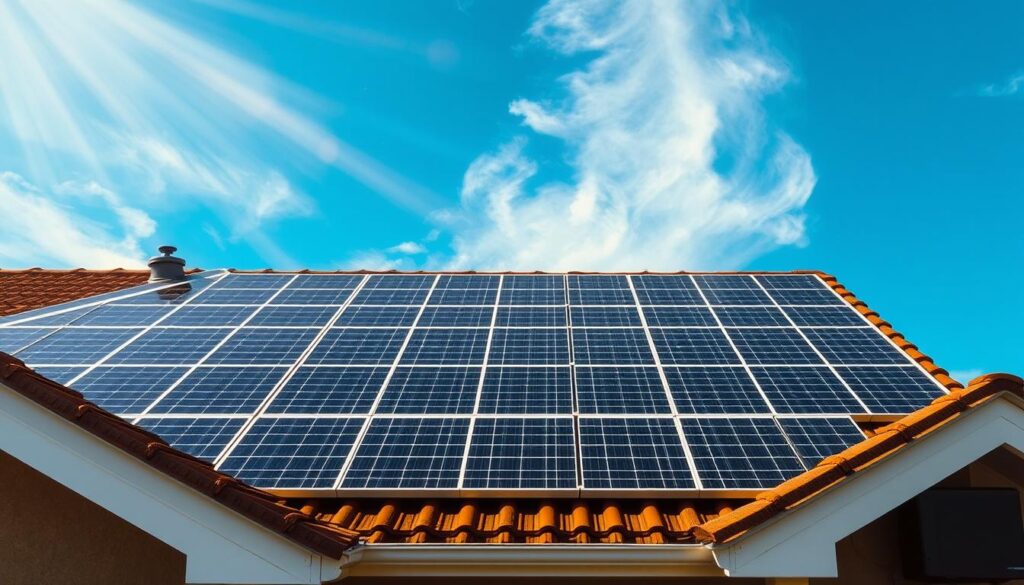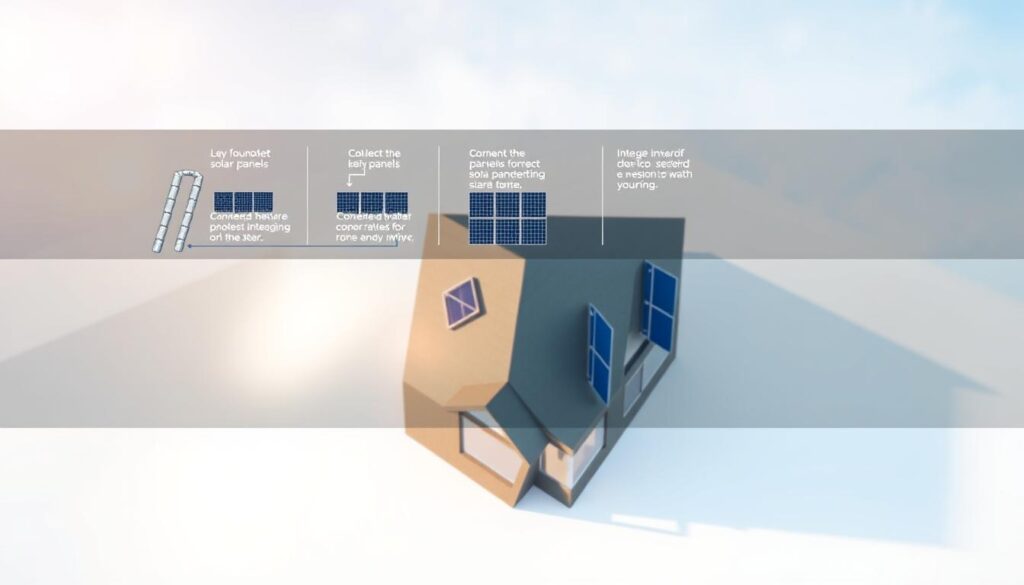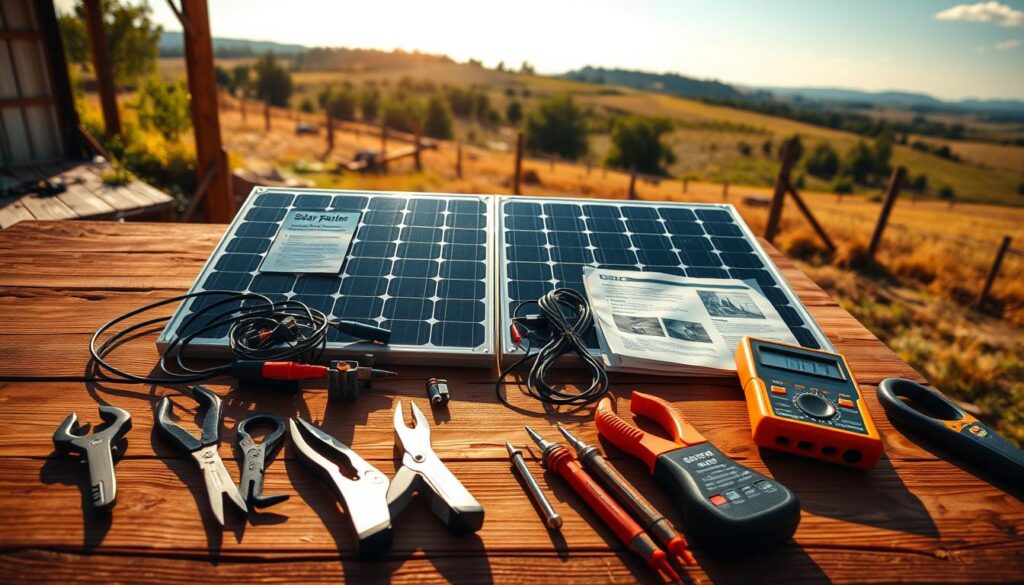Switching to sustainable energy is a smart choice for modern households. Solar power offers a clean, renewable way to meet daily energy needs. Since 2008, hundreds of thousands of installations have transformed properties across the country.
Thanks to initiatives by the U.S. Department of Energy, solar energy has become more affordable. This makes it an attractive option for homeowners looking to reduce costs and environmental impact. With advancements in technology, solar systems are now more efficient and accessible than ever.
This guide will walk you through the benefits of adopting solar energy. From understanding the technical aspects to practical tips, you’ll learn how it can enhance your property. Discover how solar power can help you contribute to a cleaner future while saving money in the long run.
Key Takeaways
- Solar energy is a clean, renewable source that reduces environmental impact.
- Since 2008, solar installations have grown significantly across the U.S.
- Government initiatives have made solar power more affordable for homeowners.
- Solar systems can increase property value and provide long-term savings.
- Regular maintenance ensures optimal performance and longevity of solar panels.
Understanding Solar Energy for Your Home
Understanding how solar energy works can help you make informed decisions about your energy use. Solar power is a renewable source that harnesses the sun’s energy to generate electricity. This process is not only eco-friendly but also highly efficient, making it a popular choice for modern households.
What Is Solar Energy and How It Works
Solar energy is produced through the photovoltaic (PV) effect, discovered in 1839. When sunlight hits a solar panel, it excites electrons in the silicon cells, creating direct current (DC) electricity. This DC power is then converted into alternating current (AC) by an inverter, making it usable for your appliances.
“Solar power is a clean, renewable energy source that reduces reliance on fossil fuels and lowers carbon emissions.”
The Role of Solar Panels and Inverters
Solar panels are the heart of any solar system. They capture sunlight and convert it into DC electricity. The inverter, on the other hand, transforms this DC power into AC, which powers your home. Together, these components ensure a seamless flow of energy.
Here’s a quick breakdown of how a solar system works:
- Sunlight hits the solar panels, generating DC electricity.
- The inverter converts DC into AC for household use.
- Excess energy can be fed back into the grid, often earning credits through net metering.
To better understand the efficiency of solar systems, here’s a comparison of energy production:
| Component | Function | Efficiency |
|---|---|---|
| Solar Panels | Capture sunlight | 15-22% |
| Inverter | Convert DC to AC | 95-98% |
| Grid Connection | Store excess energy | Varies by utility |
By understanding these components, you can appreciate how a solar system works together to provide reliable and sustainable energy. Whether you’re looking to reduce your carbon footprint or save on energy bills, solar power is a smart investment for the future.
At Home Solar: What You Need to Know
Evaluating your property for solar energy starts with understanding your roof and space. The condition, angle, and orientation of your roof are critical factors. A south-facing roof with a 30 to 50-degree angle is ideal for maximum energy production.

Before proceeding with installation, assess your roof’s structural integrity. Ensure it can support the weight of panels and withstand weather conditions. If your roof isn’t suitable, ground-mounted systems are an alternative, though they may incur additional costs.
Proper installation practices are essential for system efficiency and safety. Always work with certified professionals who comply with local building codes. This ensures your system meets safety standards and qualifies for incentives.
On a typical day, your solar system will generate electricity based on sunlight availability. Performance monitoring systems track hourly production, allowing you to optimize energy use. Excess energy can be fed back into the grid, earning credits through net metering.
To maintain peak efficiency, clean your panels regularly and inspect them for damage. Most panels are guaranteed to remain at least 80% efficient for 25 years. Proper care ensures your system delivers long-term savings.
Here’s a quick comparison of key factors to consider:
| Factor | Details |
|---|---|
| Roof Condition | Must support panel weight and withstand weather |
| Orientation | South-facing at 30-50 degrees is optimal |
| Installation | Requires certified professionals and code compliance |
| Maintenance | Regular cleaning and inspections ensure efficiency |
By evaluating these factors, you can determine if your property is ready for solar energy. A well-planned installation not only maximizes efficiency but also enhances your property’s value.
Benefits of Adopting Solar Power
Adopting solar power brings both financial and environmental rewards. It’s a practical way to lower energy bills while contributing to a healthier planet. With tax credits and incentives, the upfront cost becomes more manageable, making it an attractive option for many.
Cost Savings and Environmental Impact
One of the most immediate benefits of solar energy is the reduction in monthly utility bills. By generating your own electricity, you can significantly cut down on expenses. Over time, these savings add up, making solar power a smart financial choice.
Beyond the financial perks, solar energy helps reduce carbon emissions. This means cleaner air and a smaller environmental footprint. Every kilowatt-hour generated by solar panels replaces energy that would otherwise come from fossil fuels.
Tax credits and incentive programs further enhance the appeal. For example, the federal tax credit allows you to deduct 30% of the installation cost from your taxes. Many states also offer additional incentives, making solar power even more affordable.
Long-Term Investment and Energy Independence
Solar power is more than just a way to save money—it’s a long-term investment. By generating your own energy, you gain independence from fluctuating utility rates. This stability can protect you from future price hikes.
Additionally, solar systems increase property value. Studies show that homes with solar panels sell faster and at higher prices. This makes solar power not just an energy solution but also a smart real estate move.
With minimal maintenance and a lifespan of 25 years or more, solar panels offer reliable performance. This ensures that your investment continues to pay off for decades to come.
Steps to Plan Your Solar Installation
Planning a solar installation involves careful preparation and understanding of your property’s unique needs. From assessing your roof to choosing the right contractor, each step ensures a smooth and efficient process. Let’s break down the key stages to help you get started.

Assessing Your Roof, Space, and Energy Needs
Start by evaluating your roof’s condition, orientation, and available area. A south-facing roof with a 30 to 50-degree angle is ideal for maximum energy production. If your roof isn’t suitable, ground-mounted systems are a viable option.
Next, determine your energy needs by reviewing your utility bills. This helps you choose the right program and system size. For example, a home using 10,000 kWh annually will require a larger system than one using 5,000 kWh.
Choosing a Qualified Solar Contractor
Selecting a licensed and experienced contractor is crucial. Obtain multiple quotes to compare prices and services. Look for certifications like NABEP (North American Board of Certified Energy Practitioners) to ensure quality work.
Ask for references and check online reviews. A reputable contractor will provide a detailed proposal, including system size, estimated output, and warranty information. This ensures you get the best value for your investment.
Navigating Permits, Inspections, and Interconnection
Permits and inspections are essential for a safe and compliant installation. Your contractor will typically handle the paperwork, but it’s good to understand the process. Local building codes and utility requirements vary, so ensure all permits are secured before work begins.
After installation, an inspection ensures the system meets safety standards. Finally, your system will be connected to the grid, allowing you to start generating energy and potentially earn credits through net metering.
“A well-planned solar installation maximizes efficiency and ensures long-term savings.”
By following these steps, you can confidently plan your solar installation. From assessing your property to navigating permits, each stage brings you closer to a sustainable and cost-effective energy solution.
Exploring DIY Solar Panel Kits and Grid-Tie Systems
Exploring DIY solar panel kits offers a hands-on approach to sustainable energy. These kits are designed for technically inclined individuals who want to take control of their energy production. With all the necessary components included, they simplify the installation process while providing a cost-effective solution.

Overview of DIY Solar Panel Kits and Their Components
DIY solar panel kits typically include premium panels, microinverters, and essential hardware like racking systems and monitoring tools. Brands like IronRidge offer durable racking solutions, ensuring your system is secure and efficient. These kits are ideal for those who want to customize their setup while saving on installation costs.
Here’s a breakdown of the key components:
- Panels: Capture sunlight and convert it into electricity.
- Microinverters: Transform DC power into usable AC power.
- Racking Systems: Provide a stable foundation for panels.
- Monitoring Tools: Track energy production in real-time.
For example, a 3kW DIY kit includes 8 panels and can produce 225-500 kWh monthly. This makes it a great option for small to medium energy needs.
Understanding Grid-Tie Versus Hybrid Systems
When choosing a DIY kit, it’s important to understand the difference between grid-tie and hybrid systems. Grid-tie systems are the most affordable and connect directly to the utility grid. Excess energy is fed back into the grid, often earning credits through net metering.
Hybrid systems, on the other hand, include battery storage, allowing you to store excess energy for use during outages. While more complex, they provide greater energy independence. Here’s a comparison:
| System Type | Benefits | Limitations |
|---|---|---|
| Grid-Tie | Affordable, low maintenance | No backup during outages |
| Hybrid | Energy independence, backup power | Higher upfront cost |
For those looking to maximize their energy production, hybrid systems are a smart choice. They combine the benefits of grid-tie systems with the added security of battery storage.
“DIY solar kits empower homeowners to take control of their energy future while saving on costs.”
By understanding the components and system types, you can choose the right DIY kit for your needs. Whether you opt for a grid-tie or hybrid system, these kits provide a practical way to embrace renewable energy.
Cost, Incentives, and Financing Your Solar System
Understanding the financial aspects of solar energy can help you make smarter decisions for your property. From installation costs to long-term savings, this section breaks down everything you need to know about financing your energy system.
Installation Costs, Savings, and Solar Billing Plans
The upfront cost of installing a solar system can vary, but the long-term savings are significant. On average, a typical 11 kW system costs around $22,022. However, this investment can reduce your monthly bill by up to 90%, depending on your energy usage.
Once your system is connected to the back grid, you can take advantage of net metering. This allows you to earn credits for excess energy fed back into the grid, further lowering your rate over time.
Leveraging Tax Credits and Incentive Programs
One of the best ways to offset installation costs is through tax credits. The federal solar tax credit (ITC) offers a 30% deduction on your system’s cost until 2033. Many states also provide additional incentives, making solar power a more affordable option.
For example, Florida offers a 100% property tax exemption for residential solar systems. This means you won’t pay extra taxes on the added value to your property.
“Taking advantage of tax credits and incentives can significantly lower your upfront costs, making solar power a smart financial choice.”
Here’s a quick comparison of financing options:
- Solar Loans: Typically range from $1,000 to $100,000 with interest rates between 6% and 36%.
- Leasing: Pay a fixed monthly fee without owning the system, though you won’t benefit from long-term savings.
- PACE Financing: Attach payments to your property taxes, with no upfront costs and terms up to 25 years.
By exploring these options, you can find a plan that fits your budget and helps you save money over time. Whether you choose a loan, lease, or PACE financing, solar power is a smart investment for your future.
Maximizing Efficiency and Energy Storage
Efficient energy storage is key to maximizing the benefits of renewable power. By optimizing your system, you can ensure reliable performance and reduce reliance on the grid. This section explores how to make the most of your setup, from ground mounting options to advanced battery solutions.
Ground Mounting and Panel Orientation
Ground-mounted systems offer flexibility in positioning panels to capture the sun’s rays effectively. Unlike rooftop installations, these systems can be adjusted for optimal tilt and orientation. This ensures maximum energy production throughout the day, even in less-than-ideal conditions.
For example, a 30 to 50-degree angle is ideal for most locations. This setup is particularly useful in areas with shading or limited roof space. By choosing the right ground system, you can enhance your system’s efficiency and longevity.
Battery Options and Managing Excess Energy
Choosing the right battery is crucial for storing excess energy generated during peak sunlight hours. Lithium-ion batteries are popular for their high efficiency and long lifespan. They allow you to store energy for use during the night or on cloudy days, ensuring a consistent power supply.
Here’s a quick comparison of common battery types:
- Lithium-ion: High efficiency, long lifespan, and compact size.
- Lead-acid: Affordable but requires more maintenance and has a shorter lifespan.
- Flow batteries: Scalable and ideal for large systems but more expensive.
Properly sizing your energy storage system is equally important. A system that’s too small won’t meet your needs, while an oversized one can increase costs unnecessarily. Work with a professional to determine the right size based on your energy consumption and production.
“Effective energy storage transforms solar power into a reliable, round-the-clock energy solution.”
By combining the right battery and storage strategies, you can maximize your system’s efficiency and enjoy greater energy independence. Whether you’re looking to reduce costs or enhance reliability, these insights will help you make the most of your renewable energy investment.
Local Resources and Support in the United States
Accessing local resources can make the transition to renewable energy smoother and more affordable. From government programs to community initiatives, there are numerous ways to get support for your solar project. This section highlights the tools and experts available to help you every step of the way.
Government Programs and State-Specific Incentives
Many state governments offer programs to make solar installations more accessible. For example, California’s Solar Initiative provides rebates for residential systems, while New York offers tax credits for clean energy projects. These incentives can significantly reduce upfront costs.
Federal programs like the Solar Investment Tax Credit (ITC) also play a crucial role. This credit allows homeowners to deduct 30% of their system’s cost from federal taxes. Combined with state incentives, these programs make solar power a smart financial choice.
Community Initiatives Promoting Clean Energy
Local community initiatives are another valuable resource. Programs like the National Community Solar Partnership aim to expand access to affordable solar energy. Over 300 communities across the U.S. have earned SolSmart designations for promoting solar-friendly practices.
These initiatives often include educational workshops, financial assistance, and group purchasing programs. By joining a local community, you can benefit from shared knowledge and resources.
Finding Trusted Local Solar Experts and Contractors
Choosing the right contractor is essential for a successful installation. Start by verifying their credentials, such as NABCEP certification. Look for reviews and ask for references to ensure they have a solid track record.
Resources like the Solar Energy Industries Association (SEIA) can help you find reputable professionals. Additionally, many state solar offices provide consumer protection guides to assist homeowners in making informed decisions.
“Working with trusted experts ensures a smooth installation process and long-term system performance.”
Here are some tips for finding the right contractor:
- Check certifications and licenses.
- Read online reviews and testimonials.
- Request detailed proposals and compare quotes.
- Verify their experience with local businesses and projects.
By leveraging local resources and support, you can make the transition to solar energy easier and more cost-effective. Whether you’re exploring incentives or finding the right contractor, these tools will help you achieve your renewable energy goals.
Conclusion
Embracing renewable energy is a forward-thinking move for modern living. This guide has highlighted the technical, financial, and installation steps to help you make an informed decision. From understanding system components to leveraging incentives, every step is designed to simplify your transition.
Informed planning and the right local support are critical for a successful switch. Whether you choose traditional installations or DIY kits, reliable data and expert insights ensure a smooth process. The benefits of clean energy extend beyond cost savings, offering long-term environmental and financial rewards.
Take the next step toward sustainable energy independence. Explore your options and enjoy the long-term benefits of a greener lifestyle. With the right resources and guidance, your journey to clean energy is both achievable and rewarding.
